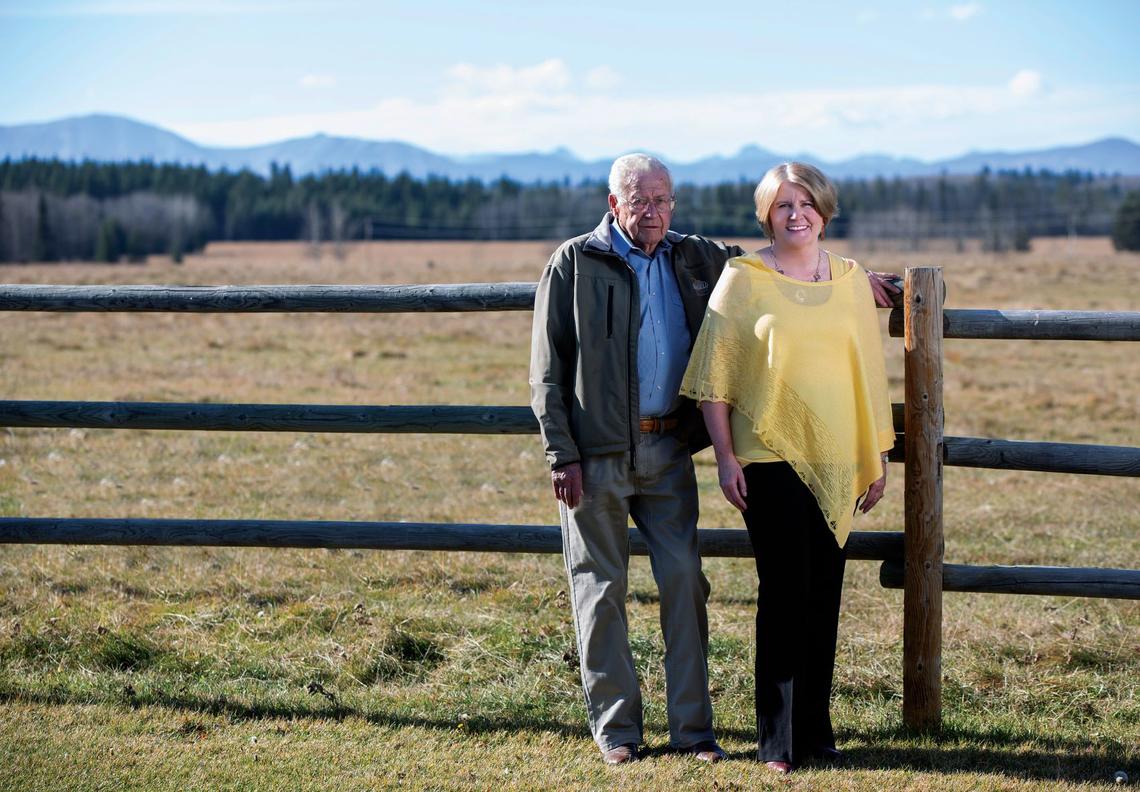Nov. 30, 2018
W.A. Ranches officially transfers a 19,000-acre living laboratory and classroom to UCalgary

Today is the day. A momentous one. The University of Calgary now has the keys to the extensive cow-calf ranch generously gifted by J.C. (Jack) Anderson and his daughter Wynne Chisholm.
Called W.A. Ranches at the University of Calgary, the working cattle operation just west of Calgary will become a world-class teaching, learning and research facility.
“It’s a fantastic and transformative opportunity,” says Dr. Ed Pajor, PhD, Anderson-Chisholm Chair in Animal Care and Welfare and the inaugural director of the ranch in charge of academic and research programming. “How often does an institution get an opportunity to build something like this?”
Not often. The $44-million, 1,000-head cattle operation is the largest ranch donation gift (monetary) in North America and the largest gift of ranch acres to a university in Canada.

The extensive cow-calf ranch was generously gifted by J.C. (Jack) Anderson and Wynne Chisholm.
University of Calgary
Since the announcement in late September, Pajor has been consulting with faculty and community stakeholders to identify ways to use W.A. Ranches in both the near and longer-term future.
“I think the ranching community is really excited about the future of W. A. Ranches,” says Pajor, who is also a professor of animal behaviour and welfare at the University of Calgary Faculty of Veterinary Medicine (UCVM).
“They’re interested in the types of activities we’re going to be doing and how it’s going to impact them, how it’s going to help them. One goal for our activities is to carry out research to improve management practices for ranchers. And we want to develop academic programming for our DVM students so we graduate better veterinarians in the long run, with more hands-on experience in cow-calf and beef cattle care.”

Ed Pajor, the director of W.A. Ranches, is in charge of academic and research programming.
Jager & Kokemor
Home on the range for vet med students
“There are a thousand mother cows out there, so there’s going to be cattle needing help,” says Dr. Rob McCorkell, associate dean, academic at UCVM. “Fourth-year students are at the stage in their education to be able to start doing diagnostic work and providing therapies under the supervision of faculty.
“And those cows are going to calve next spring, so that’s another opportunity for students. There’s always a lot of work around calving, and not necessarily just obstetrics. Young animals get into trouble. They get diseases and injuries.”
And then there are the research opportunities. Lots of them.
“Having a ranch is a game-changer,” says Dr. Hermann Schaetzl, associate dean, research at UCVM. “We now have an actual living laboratory. A ranch is an extremely complicated ecosystem and there are so many things we can study now in direct relationship to cattle, which we never could before on a real farm context: ecosystem, water and wildlife research, nutrition, microbiome, infectious diseases, and antimicrobial resistance. We can also better study things like alternatives to antibiotics. This puts our faculty, our university in an outstanding position with regard to research.”
Schaetzl says the real art lies in maintaining the normal operation of the ranch while putting its ecosystem under the microscope.
“If we start by taking half the cows for a vaccine study for instance, that actually destroys this living ecosystem,” Schaetzl says. “We really should observe it over time, and be very careful not to interfere too much.”

The 1,000-head cattle operation is the largest gift of ranch acres to a university in Canada.
Wynne Chisholm
Veterinary medicine and beyond
Owning W.A. Ranches also opens the door for university-wide collaborative research. “This is not a Faculty of Veterinary Medicine-only operation,” says Schaetzl.
“There are opportunities for research with science, research with engineering. You could do GPS-based tracing studies, and you could study how the animals move, use their pasture, the effects on water, soil, the influence of climate change, and the policies around that. The list goes on.”
“And we want to provide outreach to the cattle community,” adds Pajor. “That includes local veterinarians as well as ranchers. We want to let them know there’ll be more programming coming directed at issues they’re interested in, and that really have an impact on their ranching practices.”
The Anderson and Chisholm families’ unprecedented gift supports UCVM’s strategic plan to support and respond to the needs of Alberta’s agriculture community with clinical and diagnostic expertise, and research excellence — and to become a leader amongst research-intensive North American veterinary colleges.
Anderson and Chisholm’s gift is part of the university’s ongoing fundraising campaign, Energize: The Campaign for Eyes High, the University of Calgary’s most ambitious fundraising campaign in its history. Funds raised through the campaign will support student experiences, research outcomes and community connections. Together we are fuelling transformational change for the University of Calgary, our city, and beyond — inspiring discovery, creativity and innovation for generations to come. Formally launched in April 2016, the campaign is more than three quarters to its overall goal of $1.3 billion.

The working cattle operation will become a world-class teaching, learning and research facility.
Wynne Chisholm

